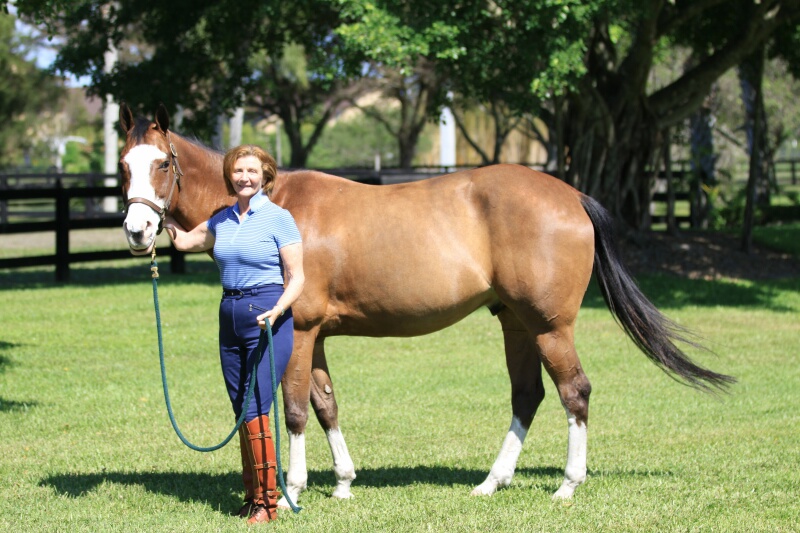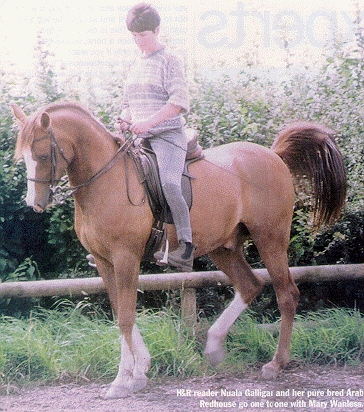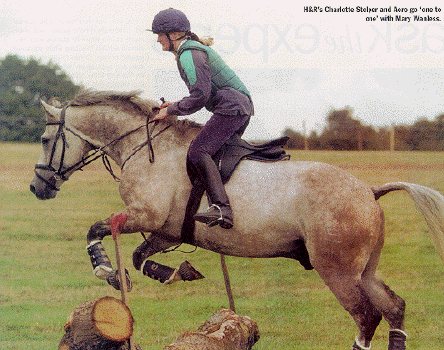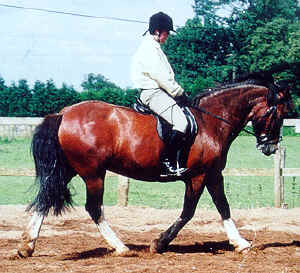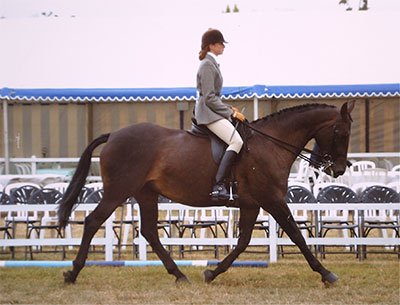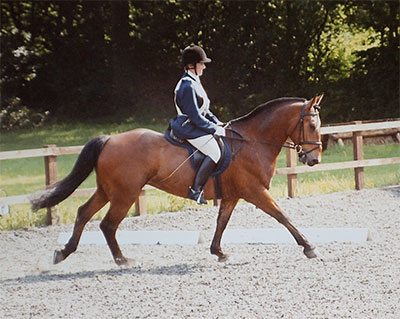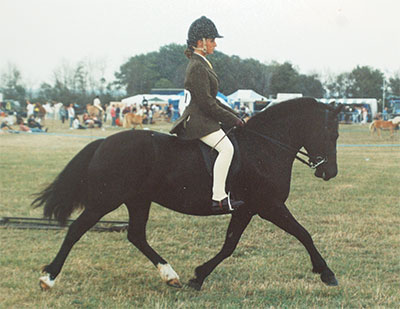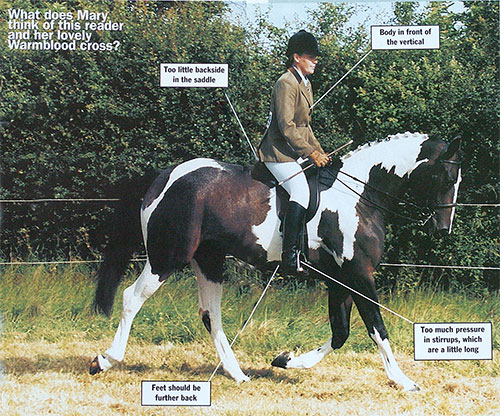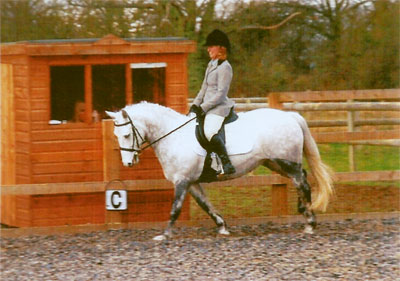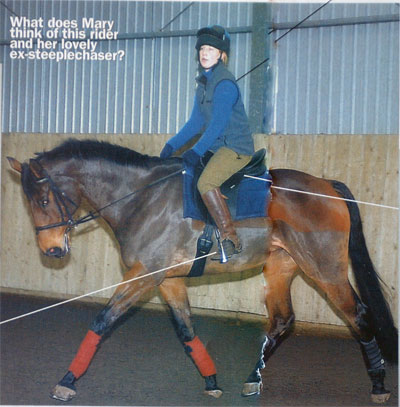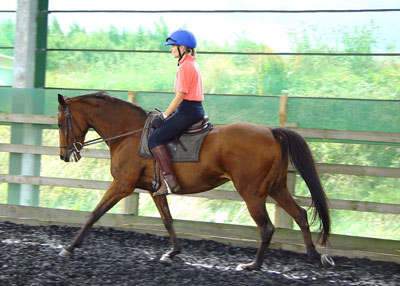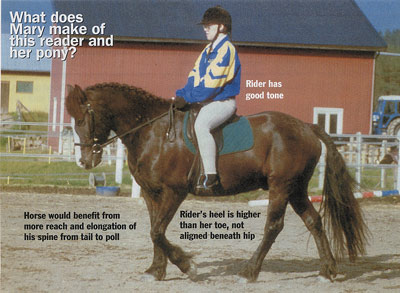RWYM
ARTICLE 19
 This photograph has been sent by a reader in Barcelona. She is riding her 25 year old thoroughbred mare, who she describes as ‘wonderful in every way and a joy to ride’. The photograph shows a lovely, and unusually ‘up-hill’ mare being basically well ridden in terms of the rider’s biomechanics. However, despite the pleasant and relatively correct look of this work, the rest of this rider’s letter to me reveals some interesting misconceptions which I believe are hampering her riding.
This photograph has been sent by a reader in Barcelona. She is riding her 25 year old thoroughbred mare, who she describes as ‘wonderful in every way and a joy to ride’. The photograph shows a lovely, and unusually ‘up-hill’ mare being basically well ridden in terms of the rider’s biomechanics. However, despite the pleasant and relatively correct look of this work, the rest of this rider’s letter to me reveals some interesting misconceptions which I believe are hampering her riding.
She says ‘I think we’re in rising trot in this picture. At least I hope we are! I tend to bump more than I’d like to in sitting trot in spite of keeping always in mind the image of my seat bones pointing forward.’ She also says ‘I have a sway back… it’s the way I’m put together. If I try to tuck in the small of my back it feels as if I’m hunching my back (shoulders) and sitting in an arm chair position. I can’t find the right balance. I’m sixty and still struggling!’ This implies to me that she herself is as well preserved as her horse! However, she is labouring under confusions which mean that the paragraph you just read did not make sense. Did you spot the mistakes?
This picture is almost certainly not of rising trot. The rider is maximally ‘up’ and maximally ‘down’ when the weight bearing diagonal pair of legs are vertical. That moment in time is never as photogenic and informative as this, when one pair of legs is arriving on the ground and the other pair is leaving it. This happens when the rider is either half way up or half way down, and if this is the case, the rider is doing an absolutely minimal rise. This does not figure with the overall picture, and I think we are seeing sitting trot, but with the rider slightly inclined forward, and with a hollow in her back.
This is where the misconceptions come in. I well believe that she is naturally sway-backed (as many women are) and this means that her seat bones will be pointing backwards. To counteract this tendency, she needs to get her seat bones to feel as if they are pointing forward. But she needs to bear in mind that all feelings are comparisons with normal, and from an objective viewpoint her seat bones will point down when she is correctly aligned. I have written consistently about the rider’s seat bones pointing down, which is a basic facet of good rider biomechanics, but have (I hope) carefully pointed out that each rider’s subjective feeling when she initially reaches this point will be tainted by the feeling she is used to.
Our rider would benefit from sitting on her hands, first of all on a hard chair, and then on her saddle. Placing them palms down will cause the least discomfort. Do this exercise too, and experiment by moving slowly between the extremes of hollowing and rounding your back. Discover what happens to your seat bones in each case. Can you find the alignment in which your seat bones point directly down to the ground? Your hands are there to help you be objective, for your subjective feeling may mislead you. We all need to bring as much objectivity as we can to our assessmens of our own rider biomechanics.
When you are riding, an observer can add objectivity by ensuring that you have a straight vertical line from your shoulder, to the boney knobble on the top outside of your thigh (the greater trochanter of the femur), to the boney knobble on the outside of your ankle. She should barely see any curves in your back, and your backside should be barely visible i.e. not sticking out behind you. There should not be that little patch of daylight underneath it that you see in the picture here.
The remedy for this rider is not tucking in the small of her back, as she suggests. She needs to tuck her tailbone more under her, bringing both her belly button and the small of her back backwards. And as she rightly suggests, this will make her feel as if she is hunching her back (shoulders) and sitting in an armchair position. But that does not make the correction wrong, as she seems to think. The biggest danger of doing it wrong lies not in her back and shoulders but in her feet, as she will then be tempted to stick them forwards.
When she is correctly aligned, our rider should have a vertical line from her pubic bone to her belly button, her sternum and her collarbone. This is another good guideline to help you establish the basics of correct rider biomechanics. If she over-kills, that line will become ‘C’ shaped with her belly button too far back. Again, she may need objective visual feedback to help her make that assessment, for she will probably feel as if she has over-corrected when actually she hasn’t. She will feel slouched and round-shouldered when objectively she isn’t. I sometimes earn my keep by convincing people to maintain this alignment when it feels so wrong to them that they were virtually kicking and screaming in disbelief and horror!
Remember what it is like to loose a filling in a tooth, or to get an ulcer in your mouth. The blemish feels enormous to your tongue, but if you look in a mirror you see a tiny little problem. It feels huge, and it looks tiny – just like the changes you make in your riding. This is the biggest single reason why people do not learn and improve as quickly and easily as they might. They censor the amount of change they are willing to make, and because they use their subjective feeling of ‘rightness’ as a guide, they refuse to stray too far from ‘home’. They do not realise how much they would gain by substituting the word ‘familiar’ for the word ‘right’. We do ourselves a great disservice when we assume they are equivalent.
There is just one other change which our rider may need to ensure that her new alignment does remain elegant. She will need to ask herself if her armpits are more closed as the front, or more closed at the back. If they are more closed at the front, she needs to close them at the back. Even if she feels scrunched and hunched, she will then look elegant; but my hope is that she has a friend with a video camera, because believing will come from seeing, and perhaps nothing else will convince her.
Getting the hollow out of her back will change her rider biomechanics significantly, and certainly go some way towards stopping her from bumping. It will also give her the possibility of staying ‘with’ the horse if she riders her more powerfully. The ethics of this may be questionable on a twenty-five year old horse, but in theory at least this needs to happen. My hunch is that the horse moves ‘within herself’ and although she is not far from tracking up, I suspect that she has (or would have had) much more power available. Is the horse being self-protective to keep herself sound and out of pain – or is the rider being self-protective, to prevent herself from bumping more and/or becoming frightened?
I would also love to see her switch her double bridle for a snaffle, and if she must ride in the double I would like to see less contact on her curb rein. There is a nice line from the rider’s elbow through her hand to the horse’s mouth, but I am left wondering if she needs the curb to stop her horse from hollowing. For under a hollow backed rider, the horse is highly likely to hollow. The biggest proof of the pudding will be the feeling of the horse’s back coming up, and of her neck reaching and arching into the rein – so naturally and inevitably that the rider feels no need to hold her head down. If the rider gave her hands forward now, would the horse maintain her alignment, reach forward and down, or hollow her back? That would be the acid test – and I am not completely sure that she would pass it. But I sincerely hope that I, at sixty, will be doing this good a job on this nice a horse!

